Journal of Southern Medical University ›› 2025, Vol. 45 ›› Issue (7): 1409-1422.doi: 10.12122/j.issn.1673-4254.2025.07.07
Previous Articles Next Articles
Liming WANG1,2( ), Hongrui CHEN1,2, Yan DU1,2, Peng ZHAO1,2,3, Yujie WANG1,2, Yange TIAN1,2,3, Xinguang LIU1,2,3(
), Hongrui CHEN1,2, Yan DU1,2, Peng ZHAO1,2,3, Yujie WANG1,2, Yange TIAN1,2,3, Xinguang LIU1,2,3( ), Jiansheng LI1,2,3
), Jiansheng LI1,2,3
Received:2025-03-24
Online:2025-07-20
Published:2025-07-17
Contact:
Xinguang LIU
E-mail:15956982550@163.com;xgliu2016@126.com
Supported by:Liming WANG, Hongrui CHEN, Yan DU, Peng ZHAO, Yujie WANG, Yange TIAN, Xinguang LIU, Jiansheng LI. Yiqi Zishen Formula ameliorates inflammation in mice with chronic obstructive pulmonary disease by inhibiting the PI3K/Akt/NF-κB signaling pathway[J]. Journal of Southern Medical University, 2025, 45(7): 1409-1422.
Add to citation manager EndNote|Ris|BibTeX
URL: https://www.j-smu.com/EN/10.12122/j.issn.1673-4254.2025.07.07
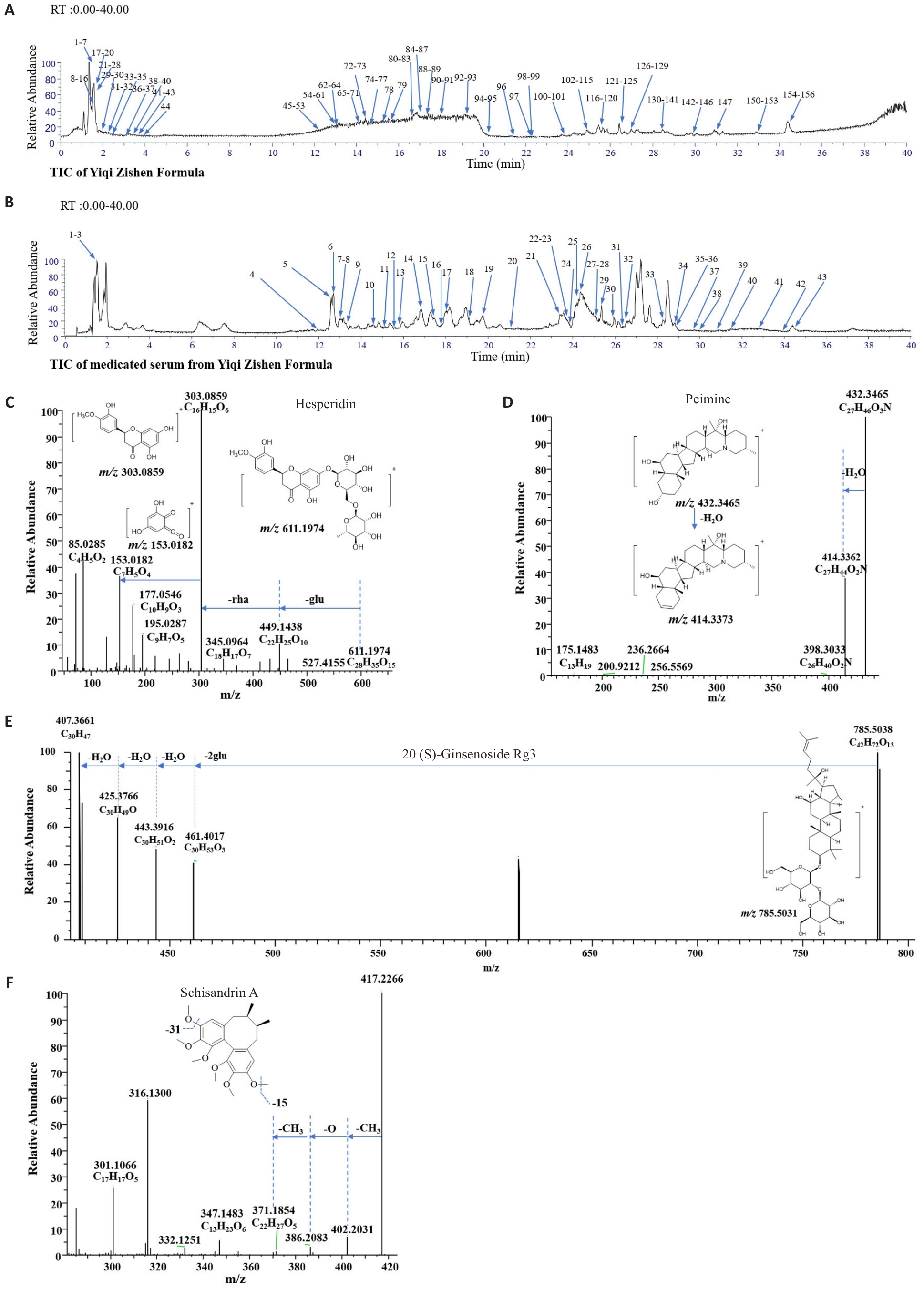
Fig.1 Identification of chemical components and prototype blood-absorbed constituents in Yiqi Zishen Formula (YZF). A: TIC of YZF in positive ion mode. B: TIC of prototype constituents of YZF in mediated rat serum in positive ion mode. C-F: MS/MS spectra and fragment assignment of hesperidin, peimine, 20(S)-ginsenoside Rg3, and schisandrin A, respectively.
| NO. | Compound | Retention time (min) | Formula | MS/MS | Error (ppm) |
|---|---|---|---|---|---|
| 1 | Synephrine | 1.6 | C9H13NO2 | 150.0917 | 1.20 |
| 2 | Histidinyl-asparagine | 1.62 | C10H13N4O3 | 192.0785; 120.0650; 103.0390 | -5.53 |
| 3 | Fructose-phenylalanine | 1.62 | C15H21NO7 | 310.1298; 292.1188 | -1.52 |
| 4 | Chlorogenic acid | 12.03 | C16H18O9 | 163.0389; 145.0285; 135.0439; 117.0336 | -6.19 |
| 5 | p-Coumaric acid O-glycoside (a) | 12.69 | C15H16O8 | 163.0390 | 1.24 |
| 6 | Schizonepetoside A | 12.72 | C16H26O7 | 169.1223 | -1.71 |
| 7 | Neostemonine or its isomer (a) | 13.15 | C18H25NO4 | 246.1492 | 0.50 |
| 8 | Croomine | 13.19 | C18H27NO4 | 248.1645 | -1.09 |
| 9 | Neostemonine or its isomer (b) | 13.43 | C18H25NO4 | 246.1491 | 0.50 |
| 10 | Verticine-N-Oxide | 14.55 | C27H45NO4 | 430.3311 | -1.44 |
| 11 | Diosmetin-6-C-glucoside | 15.06 | C22H22O11 | 445.1081; 397.0879; 367.0805 | -1.22 |
| 12 | Verticinone-N-Oxide or its isomer (a) | 15.51 | C27H43NO4 | 428.3118; 410.3059 | -1.60 |
| 13 | Verticinone-N-Oxide or its isomer (b) | 15.83 | C27H43NO4 | 428.3174; 410.3051 | -1.60 |
| 14 | Stemoninine or its isomer (a) | 16.78 | C22H31NO5 | 372.2172; 316.0912 | -2.08 |
| 15 | Stemoninine or its isomer (b) | 17.4 | C22H31NO5 | 372.2175; 316.0909 | -3.26 |
| 16 | Peimisine | 17.75 | C27H41O3N | 410.3039 | -1.85 |
| 17 | Meranzin | 18 | C15H16O4 | 189.0547 | -0.53 |
| 18 | Peimine | 19.18 | C27H45O3N | 414.3372 | -0.33 |
| 19 | TuberostemonineK/Neotuberostemonine | 19.73 | C22H33NO4 | 358.2334; 348.2545; 302.2115; 250.1802 | 0.21 |
| 20 | Peiminine | 21.25 | C27H43NO3 | 412.3218; 396.2900 | -0.91 |
| 21 | Peimine isomer | 23.46 | C27H45O3N | 414.3374 | -0.75 |
| 22 | Gomisin R | 23.74 | C22H24O7 | 383.1506; | -1.28 |
| 23 | Dihydrocapsaicin | 23.76 | C18H29NO3 | 290.2121;262.2171; 192.1391;136.0762;122.0602 | -0.90 |
| 24 | Peiminine isomer | 23.97 | C27H43NO3 | 412.3222 | -2.26 |
| 25 | Hapepunine | 24.31 | C28H47NO2 | 412.3602 | -1.44 |
| 26 | Fritillarizine/Puqiedinone | 24.4 | C27H43NO2 | 396.3281 | -1.08 |
| 27 | Gentrogenin or its isomer (a) | 25.1 | C27H40O4 | 411.2920 | 5.86 |
| 28 | Gomisin S | 25.2 | C23H30O7 | 401.1963; 369.1695 | -1.18 |
| 29 | Gentrogenin or its isomer (b) | 25.44 | C27H40O4 | 411.2888 | -3.86 |
| 30 | Methyl eugenol | 26.14 | C11H14O2 | 151.0752; 116.0011 | 0.16 |
| 31 | Schisandrol A | 26.43 | C24H32O7 | 415.2115; 400.1886; 384.1931; 369.1700; 338.1512 | -1.69 |
| 32 | Nobiletin | 26.65 | C21H22O8 | 388.1158; 373.0921; 358.0685; 355.0820; 327.0869; 211.0245 | -3.12 |
| 33 | Schisanhenol or its isomer (a) | 28.39 | C23H30O6 | 388.1881; 371.1856; 340.1665; 325.1430 | -2.42 |
| 34 | Schisantherin A | 28.85 | C30H32O9 | 415.1725; 268.9779; 91.0565 | -6.24 |
| 35 | Schisanhenol or its isomer (b) | 28.87 | C23H30O6 | 388.1876; 371.1868; 340.1668; 325.1438 | -2.42 |
| 36 | (-)-Gomisin L2 | 28.87 | C22H26O6 | 371.1465 | -1.69 |
| 37 | 9-Tetradecenoic acid | 29.8 | C14H26O2 | 209.1927 | -1.06 |
| 38 | Schisandrin A | 30.09 | C24H32O6 | 402.2043; 386.2090; 371.1852; 347.1491; 316.1307; 301.1073 | -1.23 |
| 39 | Schisandrin B | 30.88 | C23H28O6 | 386.1725; 370.1776; 355.1534; 300.0990; 285.0758 | -1.31 |
| 40 | Wuweizisu C | 31.53 | C22H24O6 | 285.0756; 257.0808; 227.0703; 212.0466 | 3.93 |
| 41 | Gondoic acid or its isomer (a) | 32.83 | C20H38O2 | 265.2524; 247.2425 | -0.57 |
| 42 | Gondoic acid or its isomer (b) | 33.96 | C20H38O2 | 293.2838 | -1.94 |
| 43 | Gondoic acid or its isomer (c) | 34.48 | C20H38O2 | 293.2824 | -3.41 |
Tab.1 Exogenous blood components of Yiqi Zishen Formula in medicated rat serum
| NO. | Compound | Retention time (min) | Formula | MS/MS | Error (ppm) |
|---|---|---|---|---|---|
| 1 | Synephrine | 1.6 | C9H13NO2 | 150.0917 | 1.20 |
| 2 | Histidinyl-asparagine | 1.62 | C10H13N4O3 | 192.0785; 120.0650; 103.0390 | -5.53 |
| 3 | Fructose-phenylalanine | 1.62 | C15H21NO7 | 310.1298; 292.1188 | -1.52 |
| 4 | Chlorogenic acid | 12.03 | C16H18O9 | 163.0389; 145.0285; 135.0439; 117.0336 | -6.19 |
| 5 | p-Coumaric acid O-glycoside (a) | 12.69 | C15H16O8 | 163.0390 | 1.24 |
| 6 | Schizonepetoside A | 12.72 | C16H26O7 | 169.1223 | -1.71 |
| 7 | Neostemonine or its isomer (a) | 13.15 | C18H25NO4 | 246.1492 | 0.50 |
| 8 | Croomine | 13.19 | C18H27NO4 | 248.1645 | -1.09 |
| 9 | Neostemonine or its isomer (b) | 13.43 | C18H25NO4 | 246.1491 | 0.50 |
| 10 | Verticine-N-Oxide | 14.55 | C27H45NO4 | 430.3311 | -1.44 |
| 11 | Diosmetin-6-C-glucoside | 15.06 | C22H22O11 | 445.1081; 397.0879; 367.0805 | -1.22 |
| 12 | Verticinone-N-Oxide or its isomer (a) | 15.51 | C27H43NO4 | 428.3118; 410.3059 | -1.60 |
| 13 | Verticinone-N-Oxide or its isomer (b) | 15.83 | C27H43NO4 | 428.3174; 410.3051 | -1.60 |
| 14 | Stemoninine or its isomer (a) | 16.78 | C22H31NO5 | 372.2172; 316.0912 | -2.08 |
| 15 | Stemoninine or its isomer (b) | 17.4 | C22H31NO5 | 372.2175; 316.0909 | -3.26 |
| 16 | Peimisine | 17.75 | C27H41O3N | 410.3039 | -1.85 |
| 17 | Meranzin | 18 | C15H16O4 | 189.0547 | -0.53 |
| 18 | Peimine | 19.18 | C27H45O3N | 414.3372 | -0.33 |
| 19 | TuberostemonineK/Neotuberostemonine | 19.73 | C22H33NO4 | 358.2334; 348.2545; 302.2115; 250.1802 | 0.21 |
| 20 | Peiminine | 21.25 | C27H43NO3 | 412.3218; 396.2900 | -0.91 |
| 21 | Peimine isomer | 23.46 | C27H45O3N | 414.3374 | -0.75 |
| 22 | Gomisin R | 23.74 | C22H24O7 | 383.1506; | -1.28 |
| 23 | Dihydrocapsaicin | 23.76 | C18H29NO3 | 290.2121;262.2171; 192.1391;136.0762;122.0602 | -0.90 |
| 24 | Peiminine isomer | 23.97 | C27H43NO3 | 412.3222 | -2.26 |
| 25 | Hapepunine | 24.31 | C28H47NO2 | 412.3602 | -1.44 |
| 26 | Fritillarizine/Puqiedinone | 24.4 | C27H43NO2 | 396.3281 | -1.08 |
| 27 | Gentrogenin or its isomer (a) | 25.1 | C27H40O4 | 411.2920 | 5.86 |
| 28 | Gomisin S | 25.2 | C23H30O7 | 401.1963; 369.1695 | -1.18 |
| 29 | Gentrogenin or its isomer (b) | 25.44 | C27H40O4 | 411.2888 | -3.86 |
| 30 | Methyl eugenol | 26.14 | C11H14O2 | 151.0752; 116.0011 | 0.16 |
| 31 | Schisandrol A | 26.43 | C24H32O7 | 415.2115; 400.1886; 384.1931; 369.1700; 338.1512 | -1.69 |
| 32 | Nobiletin | 26.65 | C21H22O8 | 388.1158; 373.0921; 358.0685; 355.0820; 327.0869; 211.0245 | -3.12 |
| 33 | Schisanhenol or its isomer (a) | 28.39 | C23H30O6 | 388.1881; 371.1856; 340.1665; 325.1430 | -2.42 |
| 34 | Schisantherin A | 28.85 | C30H32O9 | 415.1725; 268.9779; 91.0565 | -6.24 |
| 35 | Schisanhenol or its isomer (b) | 28.87 | C23H30O6 | 388.1876; 371.1868; 340.1668; 325.1438 | -2.42 |
| 36 | (-)-Gomisin L2 | 28.87 | C22H26O6 | 371.1465 | -1.69 |
| 37 | 9-Tetradecenoic acid | 29.8 | C14H26O2 | 209.1927 | -1.06 |
| 38 | Schisandrin A | 30.09 | C24H32O6 | 402.2043; 386.2090; 371.1852; 347.1491; 316.1307; 301.1073 | -1.23 |
| 39 | Schisandrin B | 30.88 | C23H28O6 | 386.1725; 370.1776; 355.1534; 300.0990; 285.0758 | -1.31 |
| 40 | Wuweizisu C | 31.53 | C22H24O6 | 285.0756; 257.0808; 227.0703; 212.0466 | 3.93 |
| 41 | Gondoic acid or its isomer (a) | 32.83 | C20H38O2 | 265.2524; 247.2425 | -0.57 |
| 42 | Gondoic acid or its isomer (b) | 33.96 | C20H38O2 | 293.2838 | -1.94 |
| 43 | Gondoic acid or its isomer (c) | 34.48 | C20H38O2 | 293.2824 | -3.41 |
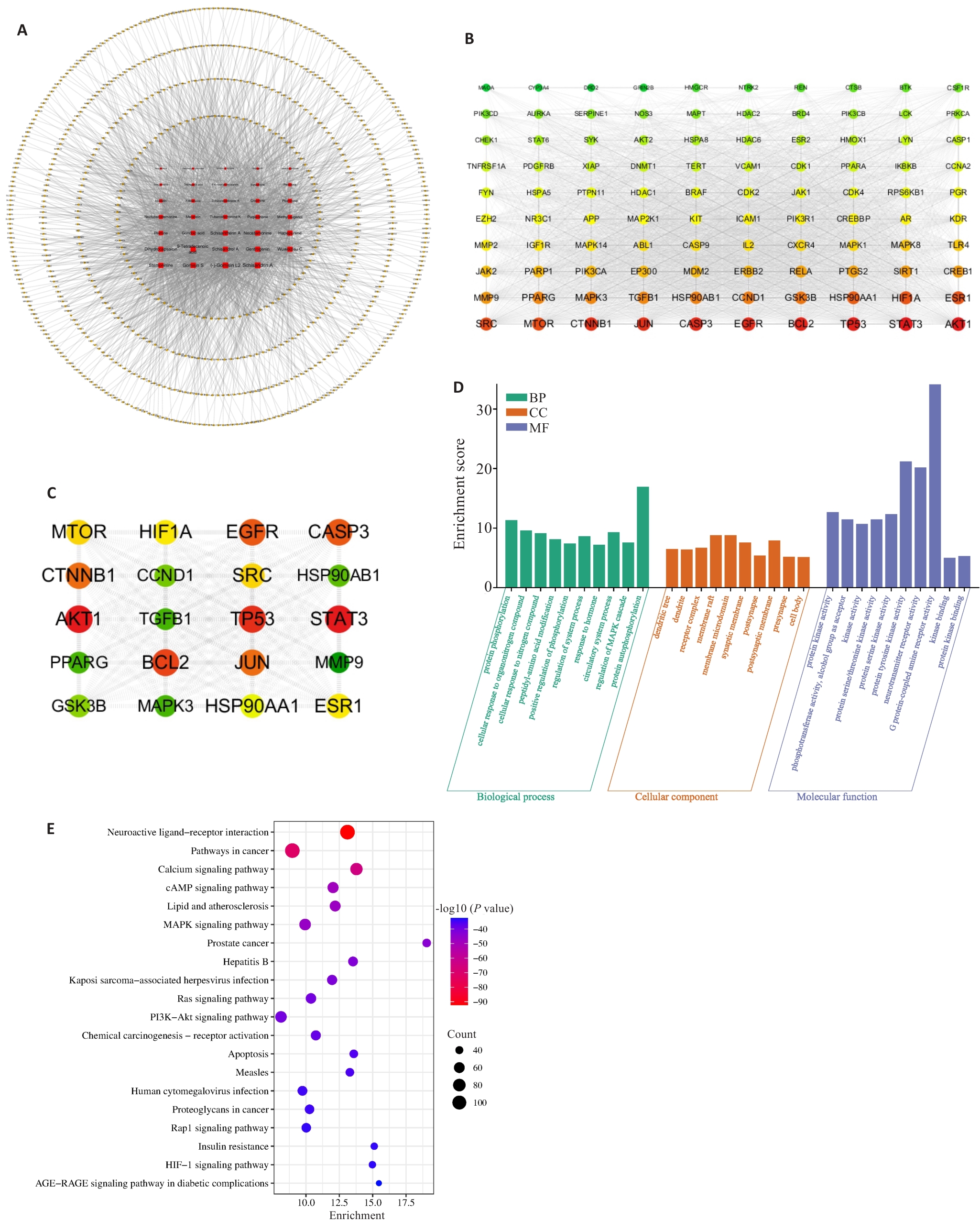
Fig.2 Network analysis of active components in YZF. A: Network diagram of 34 components and their 704 associated targets. B: PPI network diagram of the top 100 targets. C: PPI network diagram of the top 20 targets. D: GO enrichment analysis of 704 targets of YZF components. E: KEGG enrichment analysis of 704 targets of YZF components.
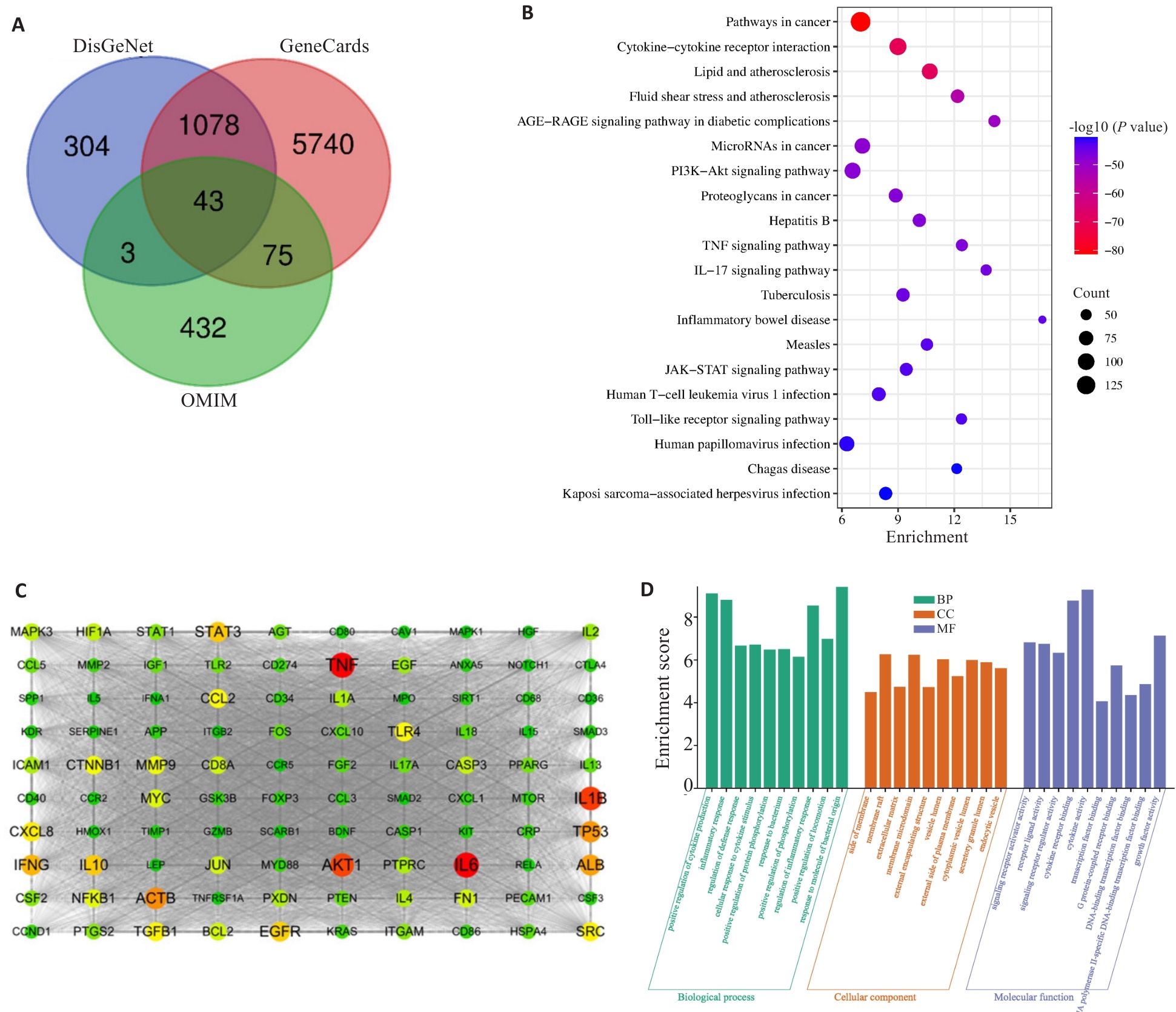
Fig.3 Network analysis of COPD Targets. A: Venn diagram of COPD targets from 3 disease databases. B: KEGG enrichment analysis of COPD disease targets. C: PPI network of the top 100 COPD targets. D: GO enrichment analysis of COPD disease targets.

Fig.4 Network analysis of shared targets between YZF and COPD. A: Venn Diagram of YZF targets and COPD disease targets. B: Component-target network construction. C: GO enrichment analysis of 184 intersection targets. D: KEGG enrichment analysis of 184 intersection targets. E: PPI network of the top 100 intersection targets. F: Core targets extracted from the 184 intersection targets.
| Ingredient | Degree | Closeness centrality | Betweenness centrality |
|---|---|---|---|
| Gomisin S | 46 | 0.4087 | 0.1222 |
| Schisandrin A | 45 | 0.4026 | 0.1143 |
| (-)-Gomisin L2 | 44 | 0.4011 | 0.1029 |
| Wuweizisu C | 38 | 0.3923 | 0.0869 |
| Schisantherin A | 35 | 0.3894 | 0.0765 |
| Dihydrocapsaicin | 34 | 0.3894 | 0.1012 |
| Schisandrol A | 34 | 0.3881 | 0.0748 |
| Gentrogenin | 33 | 0.3759 | 0.0782 |
| 9-Tetradecenoic acid | 32 | 0.3881 | 0.0940 |
| Hapepunine | 31 | 0.3853 | 0.0848 |
Tab.2 Topological parameters of top 10 active components in YZF ranked by degree value
| Ingredient | Degree | Closeness centrality | Betweenness centrality |
|---|---|---|---|
| Gomisin S | 46 | 0.4087 | 0.1222 |
| Schisandrin A | 45 | 0.4026 | 0.1143 |
| (-)-Gomisin L2 | 44 | 0.4011 | 0.1029 |
| Wuweizisu C | 38 | 0.3923 | 0.0869 |
| Schisantherin A | 35 | 0.3894 | 0.0765 |
| Dihydrocapsaicin | 34 | 0.3894 | 0.1012 |
| Schisandrol A | 34 | 0.3881 | 0.0748 |
| Gentrogenin | 33 | 0.3759 | 0.0782 |
| 9-Tetradecenoic acid | 32 | 0.3881 | 0.0940 |
| Hapepunine | 31 | 0.3853 | 0.0848 |
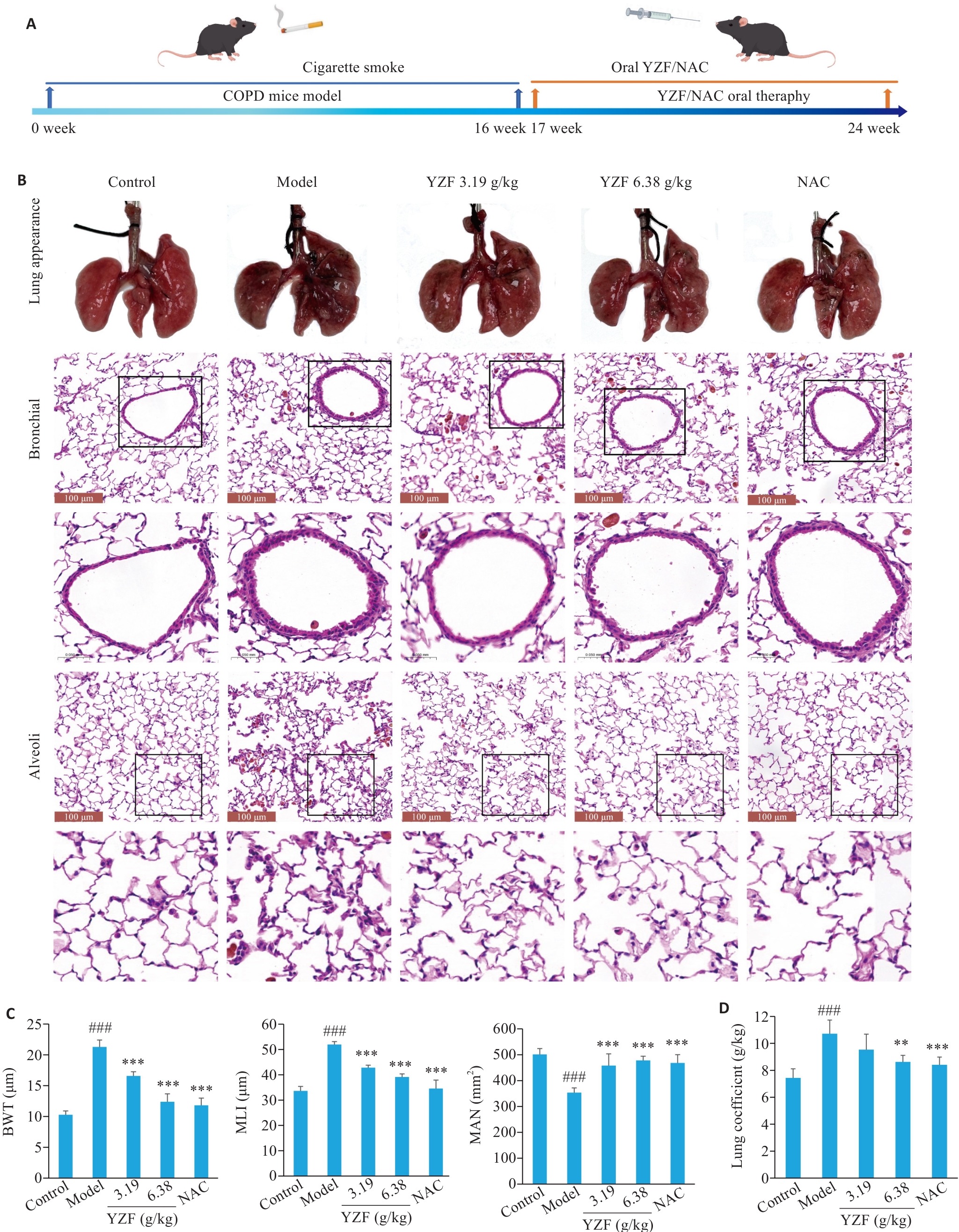
Fig.5 Animal experimental workflow and lung pathology-related indicators. A: Timeline of COPD mouse modeling and interventions. B: Lung gross appearance and HE staining of airways and alveoli in each group. C: Quantitative analysis of airways and alveoli HE staining. D: Lung coefficient (ratio of lung weight to body weight) of the mice. n=6, **P<0.01, ***P<0.001 vs Model; ###P<0.001 vs Control. YZF: Yiqi Zishen Formula; NAC: N-Acetylcysteine.
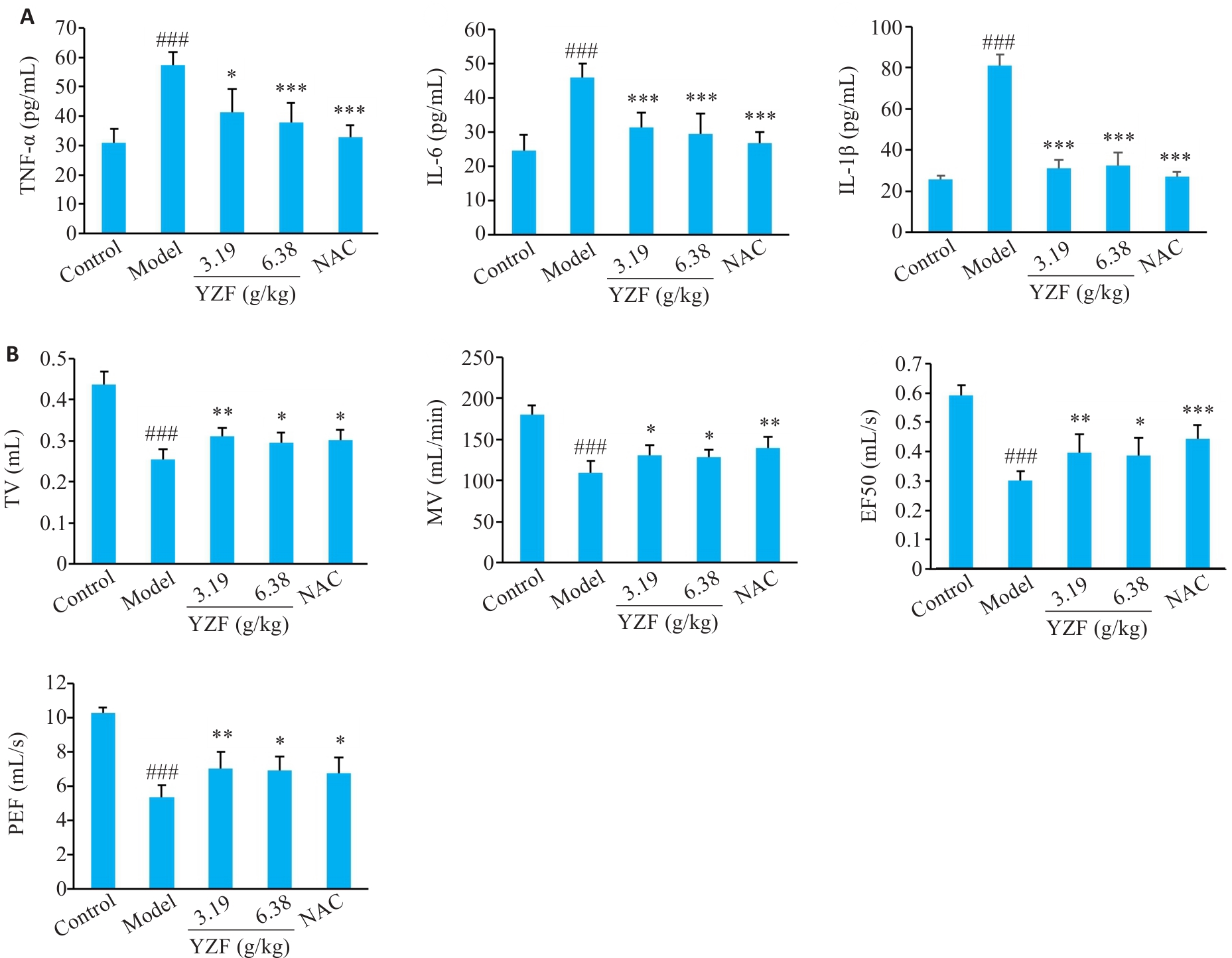
Fig.6 Changes in pulmonary function and expression of lung inflammatory cytokines in each group. A: ELISA analysis of inflammatory cytokines in each group. B: Pulmonary function in each group. n=6, *P<0.05, **P<0.01, ***P<0.001 vs Model; ###P<0.001 vs Control. YZF: Yiqi Zishen Formula.
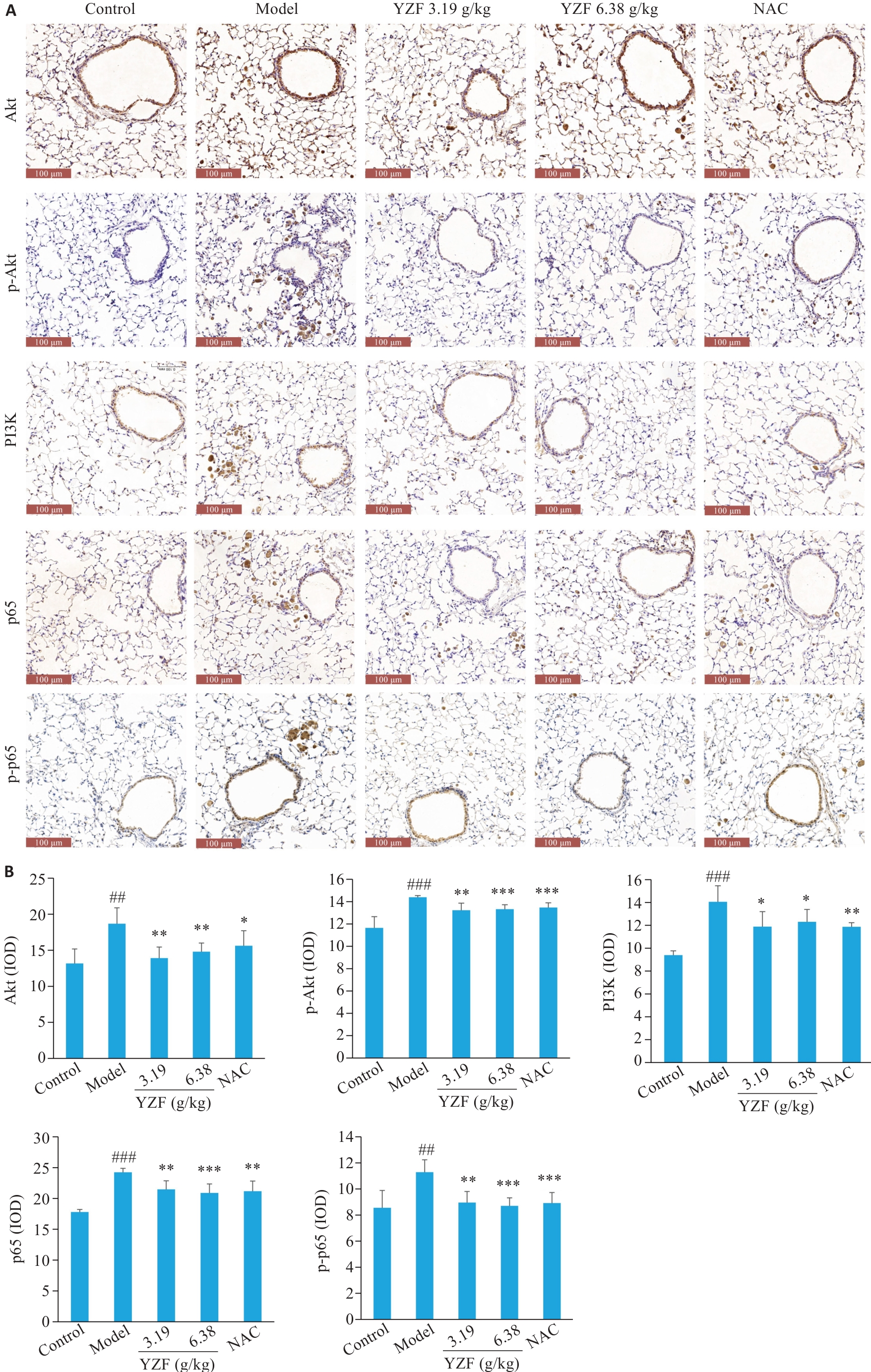
Fig.7 Immunohistochemistry and quantitative analysis of PI3K-Akt pathway-related proteins. A: Immunohistochemical (IHC) staining images of PI3K, Akt, p-Akt, p65, and p-p65 in the lung tissue. B: Integrated optical density (IOD) analysis of protein expressions in IHC staining. n=6, *P<0.05, **P<0.01, ***P<0.001 vs Model; ##P<0.01, ###P<0.001 vs Control. YZF: Yiqi Zishen Formula.
| [1] | Agustí A, Celli BR, Criner GJ, et al. Global initiative for chronic obstructive lung disease 2023 report: gold executive summary[J]. Eur Respir J, 2023, 61(4): 2300239. doi:10.1183/13993003.00239-2023 |
| [2] | 丁莉莉, 冯淬灵, 赵克明. 慢性阻塞性肺疾病中医研究进展[J]. 辽宁中医药大学学报, 2023, 25(3): 164-8. |
| [3] | 李建生, 余学庆. 慢性阻塞性肺疾病中医分期分级防治策略[J]. 中医杂志, 2019, 60(22): 1895-9. |
| [4] | Wang MH, Li JS, Li SY, et al. Effects of comprehensive therapy based on traditional Chinese medicine patterns on older patients with chronic obstructive pulmonary disease: a subgroup analysis from a four-center, randomized, controlled study[J]. Front Med, 2014, 8(3): 368-75. doi:10.1007/s11684-014-0360-0 |
| [5] | 田燕歌, 李 亚, 李建生, 等. 调补肺肾法对COPD大鼠JAK/STAT信号转导的影响及远后效应[J]. 中国中药杂志, 2013, 38(1): 75-80. doi:10.4268/cjcmm20130117 |
| [6] | Qin YQ, Chen YL, Zhao P, et al. Tiaobu Feishen therapy inhibits inflammation induced by cigarette smoke extracts in a human monocyte/macrophage cell line[J]. J Tradit Chin Med, 2021, 41(3): 360-6. doi:10.19852/j.cnki.jtcm.2021.03.003 |
| [7] | Dong HR, Liu XF, Zheng WC, et al. Three Tiaobu Feishen formulae reduces cigarette smoke-induced inflammation in human airway epithelial cells[J]. J Tradit Chin Med, 2020, 40(3): 386-92. |
| [8] | Chen YL, Wu YS, Li JS, et al. Three Tiaobu Feishen therapies protect human alveolar epithelial cells against cigarette smoking and tumor necrosis factor: induced inflammation by nuclear factor-kappa B pathway[J]. J Tradit Chin Med, 2019, 39(1): 45-9. |
| [9] | 李高峰, 刘淑娟, 李 亚, 等. 调补肺肾三法通过抑制ERK1/2信号通路改善COPD大鼠气道黏液高分泌[J]. 中国实验动物学报, 2024, 32(4): 411-22. |
| [10] | 陈旺宇, 节笑笑, 陈甜甜, 等. 中药血清药物化学研究现状[J]. 中国医药科学, 2023, 13(4): 26-9, 86. |
| [11] | Arifin WN, Zahiruddin WM. Sample size calculation in animal studies using resource equation approach[J]. Malays J Med Sci, 2017, 24(5): 101-5. doi:10.21315/mjms2017.24.5.11 |
| [12] | 国家药典委员会. 中华人民共和国药典-三部: 2020年版[M]. 北京: 中国医药科技出版社, 2020. |
| [13] | Wu JY, Cai BR, Zhang A, et al. Chemical identification and antioxidant screening of Bufei yishen formula using an offline DPPH ultrahigh-performance liquid chromatography Q-extractive orbitrap MS/MS[J]. Int J Anal Chem, 2022, 2022: 1423801. doi:10.1155/2022/1423801 |
| [14] | Shao D, Liu XG, Wu JY, et al. Identification of the active compounds and functional mechanisms of Jinshui Huanxian formula in pulmonary fibrosis by integrating serum pharmacochemistry with network pharmacology[J]. Phytomedicine, 2022, 102: 154177. doi:10.1016/j.phymed.2022.154177 |
| [15] | 梅晓峰, 赵 鹏, 卢瑞龙, 等. 慢性阻塞性肺疾病小鼠模型制备方法的比较研究[J]. 中国病理生理杂志, 2022, 38(1): 178-85. doi:10.3969/j.issn.1000-4718.2022.01.023 |
| [16] | Ye JB, Ren G, Li WY, et al. Characterization and identification of prenylated flavonoids from Artocarpus heterophyllus lam. roots by quadrupole time-of-flight and linear trap quadrupole orbitrap mass spectrometry[J]. Molecules, 2019, 24(24): 4591. doi:10.3390/molecules24244591 |
| [17] | 慢性阻塞性肺疾病中西医结合管理专家共识写作组, 何权瀛, 冯淬灵. 慢性阻塞性肺疾病中西医结合管理专家共识(2023版)[J]. 中国全科医学, 2023, 26(35): 4359-71. |
| [18] | 徐砚通, 唐雅楠. 方剂“组-谱-效-机” 研究模式探讨[J]. 中国中药杂志, 2025, 50(3): 840-5. doi:10.19540/j.cnki.cjcmm.20241017.601 |
| [19] | 祁建宏, 董芳旭. 黄酮类化合物药理作用研究进展[J]. 北京联合大学学报, 2020, 34(3): 89-92. doi:10.16255/j.cnki.ldxbz.2020.03.014 |
| [20] | Hosawi S. Current update on role of hesperidin in inflammatory lung diseases: chemistry, pharmacology, and drug delivery approaches[J]. Life (Basel), 2023, 13(4): 937. doi:10.3390/life13040937 |
| [21] | Liu CL, Zhu XM, Aga EB, et al. Ebeiedinone and peimisine inhibit cigarette smoke extract-induced oxidative stress injury and apo-ptosis in BEAS-2B cells[J]. Cell Stress Chaperones, 2024, 29(6): 697-708. doi:10.1016/j.cstres.2024.10.001 |
| [22] | 李凡凡, 郑越超. 天然生物碱抗菌活性及机理研究[J]. 医学信息, 2021, 34(17): 49-52. doi:10.3969/j.issn.1006-1959.2021.17.013 |
| [23] | Wang LN, Zhang YX, Song ZM, et al. Ginsenosides: a potential natural medicine to protect the lungs from lung cancer and inflammatory lung disease[J]. Food Funct, 2023, 14(20): 9137-66. doi:10.1039/d3fo02482b |
| [24] | Zeng JM, Liao SD, Liang Z, et al. Schisandrin A regulates the Nrf2 signaling pathway and inhibits NLRP3 inflammasome activation to interfere with pyroptosis in a mouse model of COPD[J]. Eur J Med Res, 2023, 28(1): 217. doi:10.1186/s40001-023-01190-8 |
| [25] | Guo Q, Jin YZ, Chen XY, et al. NF-κB in biology and targeted therapy: new insights and translational implications[J]. Signal Transduct Target Ther, 2024, 9(1): 53. doi:10.1038/s41392-024-01757-9 |
| [26] | Liu YH, Kong HB, Cai HP, et al. Progression of the PI3K/Akt signaling pathway in chronic obstructive pulmonary disease[J]. Front Pharmacol, 2023, 14: 1238782. doi:10.3389/fphar.2023.1238782 |
| [27] | 杨 洋, 李竹英, 田春燕, 等. 中医药干预慢性阻塞性肺疾病相关信号通路的研究进展[J]. 中国实验方剂学杂志, 2024, 30(15): 244-55. |
| [28] | 张 钰, 涂 星, 张 燕, 等. 文王一支笔的抗炎作用机制: 基于网络药理学、分子对接及实验验证[J]. 南方医科大学学报, 2023, 43(3): 383-92. doi:10.12122/j.issn.1673-4254.2023.03.07 |
| [29] | 白莉敏, 吕 行, 任引刚, 等. miR-22-3p通过激活PTEN/PI3K/AKT/NF-κB信号通路加重慢性阻塞性肺疾病[J]. 现代生物医学进展, 2023, 23(10): 1835-42. |
| [30] | Thongin S, Den-Udom T, Uppakara K, et al. Beneficial effects of capsaicin and dihydrocapsaicin on endothelial inflammation, nitric oxide production and antioxidant activity[J]. Biomed Pharmacother, 2022, 154: 113521. doi:10.1016/j.biopha.2022.113521 |
| [31] | Dong Y, Zou YZ, Li T, et al. Schisandrol a alleviates allergic asthma in mice via regulating the NF-κB/IκBα and Nrf2/HO-1 signaling pathways[J]. J Med Food, 2025, 28(1): 28-37. doi:10.1089/jmf.2024.k.0117 |
| [32] | Chen JM, Li M, Chen R, et al. Gegen Qinlian standard decoction alleviated irinotecan-induced diarrhea via PI3K/AKT/NF-κB axis by network pharmacology prediction and experimental validation combination[J]. Chin Med, 2023, 18(1): 46. doi:10.1186/s13020-023-00747-3 |
| [33] | Kim JS, Yi HK. Schisandrin C enhances mitochondrial biogenesis and autophagy in C2C12 skeletal muscle cells: potential invo-lvement of anti-oxidative mechanisms[J]. Naunyn Schmiedebergs Arch Pharmacol, 2018, 391(2): 197-206. doi:10.1007/s00210-017-1449-1 |
| [34] | Qin YQ, Yang JF, Li HB, et al. Recent advances in the therapeutic potential of nobiletin against respiratory diseases[J]. Phyto-medicine, 2024, 128: 155506. doi:10.1016/j.phymed.2024.155506 |
| [1] | Xinyuan CHEN, Chengting WU, Ruidi LI, Xueqin PAN, Yaodan ZHANG, Junyu TAO, Caizhi LIN. Shuangshu Decoction inhibits growth of gastric cancer cell xenografts by promoting cell ferroptosis via the P53/SLC7A11/GPX4 axis [J]. Journal of Southern Medical University, 2025, 45(7): 1363-1371. |
| [2] | Zhengyuan FAN, Zihan SHEN, Ya LI, Tingting SHEN, Gaofeng LI, Suyun LI. Protective effect of Bufei Yishen Formula against cigarette smoke extract-induced human bronchial epithelial cell damage and its mechanism [J]. Journal of Southern Medical University, 2025, 45(7): 1372-1379. |
| [3] | Yinfu ZHU, Yiran LI, Yi WANG, Yinger HUANG, Kunxiang GONG, Wenbo HAO, Lingling SUN. Therapeutic mechanism of hederagenin, an active component in Guizhi Fuling Pellets, against cervical cancer in nude mice [J]. Journal of Southern Medical University, 2025, 45(7): 1423-1433. |
| [4] | Lijun HE, Xiaofei CHEN, Chenxin YAN, Lin SHI. Inhibitory effect of Fuzheng Huaji Decoction against non-small cell lung cancer cells in vitro and the possible molecular mechanism [J]. Journal of Southern Medical University, 2025, 45(6): 1143-1152. |
| [5] | Xinheng WANG, Xiaohan SHAO, Tongtong LI, Lu ZHANG, Qinjun YANG, Weidong YE, Jiabing TONG, Zegeng LI, Xiangming FANG. Pingchuanning Formula suppresses airway inflammation in a rat model of asthmatic cold syndrome by regulating the HMGB1/Beclin-1 axis-mediated autophagy [J]. Journal of Southern Medical University, 2025, 45(6): 1153-1162. |
| [6] | Guoyong LI, Renling LI, Yiting LIU, Hongxia KE, Jing LI, Xinhua WANG. Therapeutic mechanism of Arctium lappa extract for post-viral pneumonia pulmonary fibrosis: a metabolomics, network pharmacology analysis and experimental verification [J]. Journal of Southern Medical University, 2025, 45(6): 1185-1199. |
| [7] | Liping GUAN, Yan YAN, Xinyi LU, Zhifeng LI, Hui GAO, Dong CAO, Chenxi HOU, Jingyu ZENG, Xinyi LI, Yang ZHAO, Junjie WANG, Huilong FANG. Compound Centella asiatica formula alleviates Schistosoma japonicum-induced liver fibrosis in mice by inhibiting the inflammation-fibrosis cascade via regulating the TLR4/MyD88 pathway [J]. Journal of Southern Medical University, 2025, 45(6): 1307-1316. |
| [8] | Peipei TANG, Yong TAN, Yanyun YIN, Xiaowei NIE, Jingyu HUANG, Wenting ZUO, Yuling LI. Tiaozhou Ziyin recipe for treatment of premature ovarian insufficiency: efficacy, safety and mechanism [J]. Journal of Southern Medical University, 2025, 45(5): 929-941. |
| [9] | Lu ZHANG, Huanzhang DING, Haoran XU, Ke CHEN, Bowen XU, Qinjun YANG, Di WU, Jiabing TONG, Zegeng LI. Shenqi Buzhong Formula ameliorates mitochondrial dysfunction in a rat model of chronic obstructive pulmonary disease by activating the AMPK/SIRT1/PGC-1α pathway [J]. Journal of Southern Medical University, 2025, 45(5): 969-976. |
| [10] | Xiaotao LIANG, Yifan XIONG, Xueqi LIU, Xiaoshan LIANG, Xiaoyu ZHU, Wei XIE. Huoxue Shufeng Granule alleviates central sensitization in chronic migraine mice via TLR4/NF-κB inflammatory pathway [J]. Journal of Southern Medical University, 2025, 45(5): 986-994. |
| [11] | Yang YANG, Kai WANG, Jianxiu LIU, Zhimo ZHOU, Wen JIA, Simou WU, Jinxing LI, Fang HE, Ruyue CHENG. Early life Bifidobacterium bifidum BD-1 intervention alleviates hyperactivity of juvenile female rats with attention deficit hyperactivity disorder [J]. Journal of Southern Medical University, 2025, 45(4): 702-710. |
| [12] | Niandong RAN, Jie LIU, Jian XU, Yongping ZHANG, Jiangtao GUO. n-butanol fraction of ethanol extract of Periploca forrestii Schltr.: its active components, targets and pathways for treating Alcheimer's disease in rats [J]. Journal of Southern Medical University, 2025, 45(4): 785-798. |
| [13] | Jinshui ZHANG, Shuo LI, Dongdong WEI, Xin CHENG, Yun DENG, Youzhi ZHANG. Protective effect of graphene heating film far-infrared hyperthermia against frostbite in mice [J]. Journal of Southern Medical University, 2025, 45(3): 522-530. |
| [14] | Haonan¹ XU, Fang³ ZHANG, Yuying² HUANG, Qisheng⁴ YAO, Yueqin⁴ GUAN, Hao CHEN. Thesium chinense Turcz. alleviates antibiotic-associated diarrhea in mice by modulating gut microbiota structure and regulating the EGFR/PI3K/Akt signaling pathway [J]. Journal of Southern Medical University, 2025, 45(2): 285-295. |
| [15] | Junjie GAO, Kai YE, Jing WU. Quercetin inhibits proliferation and migration of clear cell renal cell carcinoma cells by regulating TP53 gene [J]. Journal of Southern Medical University, 2025, 45(2): 313-321. |
| Viewed | ||||||
|
Full text |
|
|||||
|
Abstract |
|
|||||